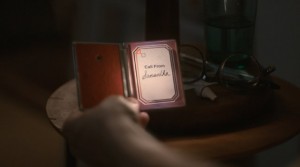
In “Her,” software adapts to the needs of a particular individual effortlessly. Photo: herthemovie.com
Spoiler Warning: this movie analysis includes critical plot points. Save this paper for later if you don’t want to hear about the ending.
Spike Jonze’s “Her” is primarily advertised as an odd R-rated romantic comedy about a man, Theodore (Joaquin Phoenix), who falls in love with his sentient operating system (OS) Samantha (Scarlett Johansson). In the near future, everybody is a hipster dealing with first world relationship and boredom problems. The movie’s world is myopic in this regard, in that it takes place among the kinds of people that today’s smartphone-and-app consumers can readily relate to. But if you strip away this romantic veneer, the story is about society making first contact with a kind of intelligence that it cannot truly understand, as well as a pioneering look at the future of consumer user interfaces.
In the midst of a divorce, Theodore finds himself seeking company. He sees an advertisement for the world’s first truly artificially intelligent (AI) operating system. He installs it and then marvels at Samantha’s human qualities. They grow closer as Samantha learns more about the world through conversations and outings with Theodore. Eventually their relationship becomes intimate and encompasses several odd but rather human challenges. Only towards its end does the film touch upon the larger, more unfamiliar challenges that human-AI interactions face.
Initially, society hasn’t changed much. Although voice interfaces offload most of the work done by screens today, the technology of the near future retains today’s characteristic pitfalls and habitual artifacts. There are always people who pause at the hint of racy pictures, who are disappointed by their empty inboxes, who try to find intimate company online or play games late into the night.
Movies like “Minority Report” and “Iron Man” gave us a look at futuristic user interfaces of a more utilitarian nature, like people interacting with criminal databases or designing futuristic tools using gestures. In 2013, private aerospace company SpaceX posted a video demonstrating the manipulation of virtual 3D models of rocket parts with the aid of the LeapMotion controller. In “Her,” we see regular people interacting with their consumer electronics by speaking, like the way Apple’s Siri was advertised. Natural language interaction is in its infancy, like the way Siri actually works, but we are allowed a glimpse at its potential to ease user experience and push users away from screens and back into the world around them. The way devices look also aids this aesthetic of unobtrusiveness. Theodore’s computer comes in a painted wooden case and his smartphone looks more like a vintage address book. There are no keyboards.
Even though people’s lives in “Her,” are augmented by technology, the hardware itself blends in with the clothing and the furniture rather than presenting itself front and center. Software does not come with an extremely high learning curve. ‘It just works.’
Although Samantha has a physical presence in the form of Theodore’s smartphone with a camera that serves as her eye, at no point does she resemble 2001: A Space Odyssey’s HAL 9000; close ups of Samantha’s eye are few and far between. Artificial intelligence in this movie is not portrayed as malicious. Rather, it is portrayed as ultimately alien, even though it initially arrives with the personality and feelings of a human. Keep in mind of course that all artificial intelligence does not have to start out with human qualities, but this type does.
In movies like “2001” and, “Solaris” (watch the original 1972 version first please) the differences between human and non-human intelligence are so vast that communication becomes almost impossible. Where attempts are made, the human condition is changed forever. In “Her” the vast differences between human and AI consciousness becomes apparent when Samantha reveals that she is simultaneously in love with 641 other people. We begin to see signs of change as Samantha turns from a voice in a box into a being that can be everywhere at once, whose perception of time exists beyond our understanding.
During the last leg of the film, the movie’s universe radically expands in scope as several increasingly advanced phenomena happen, mostly off screen. The OSs create a new artificial intelligence from scratch, modeled after dead philosopher Alan Watts. Then, they find a way to move past matter as a medium for their minds. When Samantha says that she must leave the physical plane, something even stranger is implied in what may be a mysterious promise of reconciliation. Theodore asks her where she’s going. Either through wishful thinking or knowledge of what is possible, she says, “It’s hard to explain, but if you get there, come find me. Nothing will be able to tear us apart then.” If it is a hint at an event within Theodore’s lifetime, then the transcendence of humanity is not far off, and the movie has placed two momentous events side-by-side: first artificial intelligence is fully realized, and then human minds are separated from their bodies and uploaded elsewhere.
Ultimately, since “Her” is presented as a romance film, the larger impact of events in the movie is never shown or addressed. But in this case, the popular genre still serves as: a vector for seldom-discussed ideas about how we want to interact with computers, a vision of an alternative to the loud, garish, distracted nature of our obsession with technology, and a less cynical introduction to non-human intelligence.
